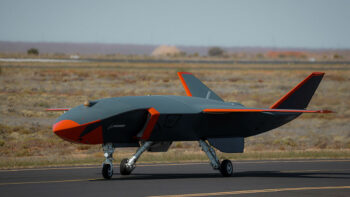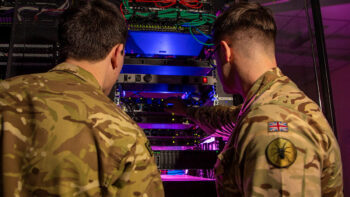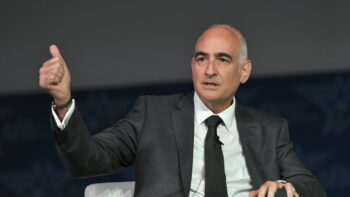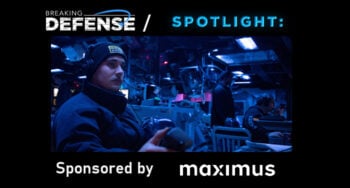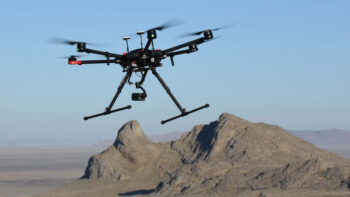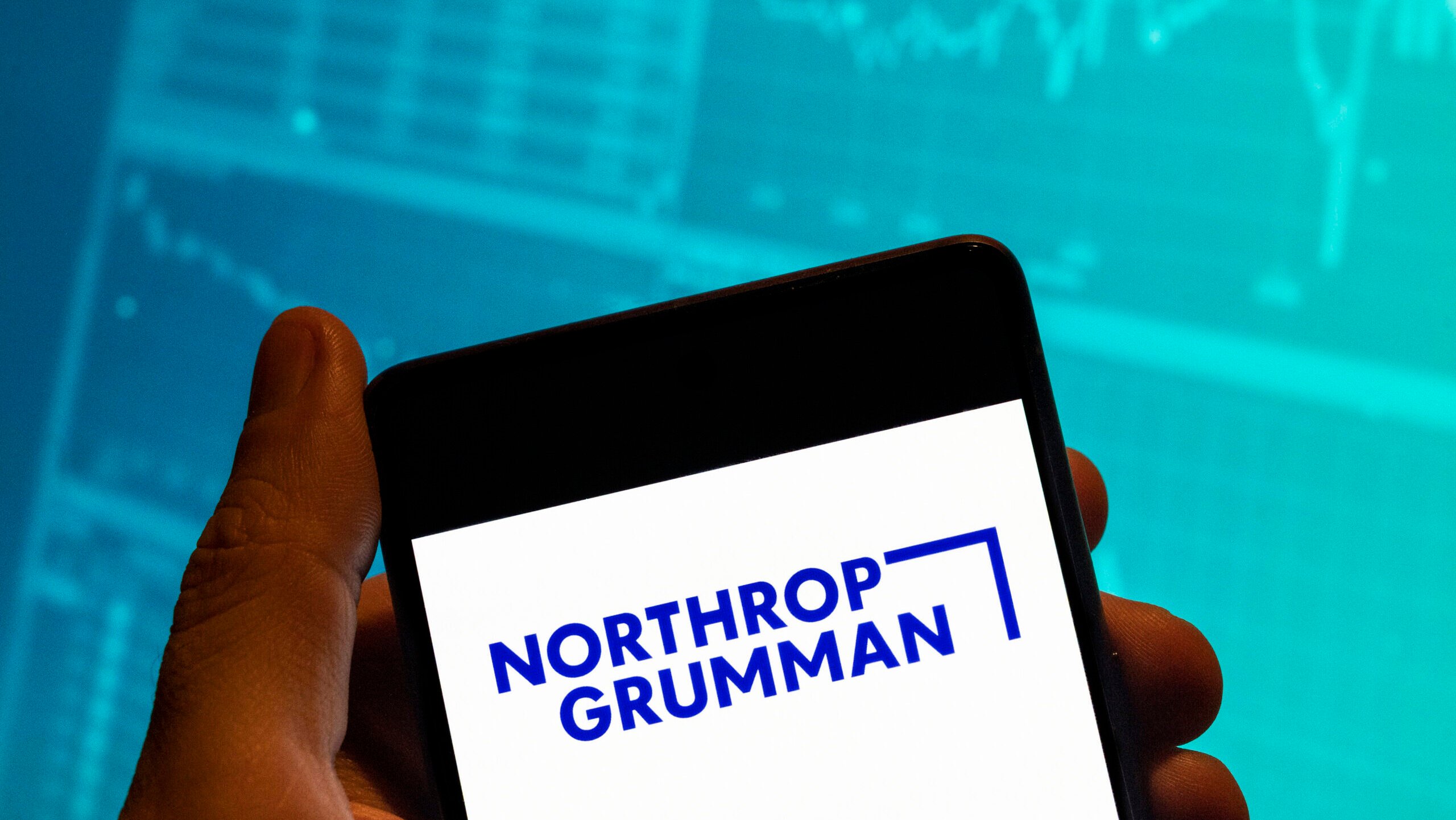
Northrop Grumman seeks to expand its global presence. (Photo Illustration by Budrul Chukrut/SOPA Images/LightRocket via Getty Images)
WASHINGTON — Northrop Grumman is one of the largest defense companies in the world, but for years has been less export-focused than its competitors. It’s a trend that CEO Kathy Warden is now looking to change, with the company under orders to provide double-digit compound annual growth rate from international sales over the next decade.
“You can check from the financials that Northrop Grumman’s international business kind of trails the rest of the industry quite a bit,” admits Steve O’Bryan, a longtime industry executive who Warden hired in January as the company’s Chief Global Business Development Officer, as the company seeks what O’Bryan called “a fresh approach” to the global market.
Speaking to Breaking Defense last week, O’Bryan laid out the strategy Northrop is pursuing to reach Warden’s target. As he describes it, there are three core prongs for the plan.
The first prong O’Bryan outlined is “focus,” saying “All too often you start spreading yourself too thin, too many different countries, you don’t have a focused effort, where your products, your team, your capabilities, can provide the best to your customers.”
As a result, Northrop has identified six key markets to target: Poland, the United Kingdom, South Korea, Japan, Taiwan and Australia.
While stressing that doesn’t mean the company is ignoring other international buyers, O’Bryan said the decision to focus on those six is driven by the status of their domestic industrial capabilities and how they fit into Northrop’s broader supply chain, as well as by a belief that the capabilities Northrop is offering will match well with customer needs.
The second prong is partnering with local industry as much as possible, which is where O’Bryan’s past as a key executive for Lockheed Martin on the F-35 Joint Strike Fighter program comes into play.
The strategy for the F-35 was to make sure local industry in every partner country had a piece of the overall F-35 production effort, so that when it came time for countries to make the final go/no-go decision on buying the stealth fighter, they had domestic jobs and dollars at stake. As someone who directly had a hand in setting up those international partnerships, O’Bryan said he sees taking “a page out of the F-35 playbook” as a winning strategy.
“Say what you want about that program, but as you and I know, the industrial strategy and the relationships it brought and the best value … is a way to establish the relationship and become part of the fabric of a country’s defense industry,” he said. “And those are the type of relationships that allow you to have a successful international business.”
Industrial players like Poland’s PGZ, Japan’s Mitsubishi Heavy Industries or South Korea’s KAI are fairly built-up entities in their own right, O’Bryan said, so bringing them into Northrop’s supply chain won’t pose a challenge. That all “equates to a better way to get a more affordable supply chain and second sources onto a program,” he said. (The desire for second sourcing, particularly after the COVID experience, is one that O’Bryan emphasized several times.)
Asked about criticisms that the F-35’s international industrial base helped lead to the planes infamous delayed schedule, O’Bryan defended his belief that the setup led to savings overall for the US government customer, while noting there were lessons to be taken away from what worked and what didn’t.
“The thing we did learn is make sure you go to a capable company with engineering experience, and keep them within their comfort zone, and don’t stray outside their capabilities,” he said. “And they generally returned incredibly best value, and you generate value for everyone.”
The final prong in Northrop’s strategy is working closely with the US customers in the region, such as US Air Forces Europe, US Air Forces Pacific, 6th Fleet and 7th Fleet, to make sure the local nations understand the interoperability that comes from buying US — and specifically, Northrop — produced equipment.
Seeing those local US forces use the equipment means a country “can see that capability, they understand what interoperability means, and understand what the capability means. It ends up being a way where they can imagine themselves operating this equipment and what it means in terms of the partnership with the US and the interoperability with forces in the region,” O’Bryan said.
Byron Callan, an analyst with Capital Alpha Partners, told Breaking Defense that in some ways a focus for Northrop Grumman on foreign sales is a throwback for the company, as far back as when the F-5 (produced by the firm then known only as Northrop) was targeted heavily at an export market. And while Callan sees potential markets abroad for Northrop goods, he’s cautious about whether the company can hit the target laid out by Warden.
That’s in part, he said, because Northrop has two major non-export programs coming online in the next decade in the B-21 stealth bomber and Sentinel ICBM. Those US-only programs will drive major funds to Northrop’s coffers, but means even increased foreign sales likely won’t keep pace.
“You’re going to try and double sales internationally — From an absolute standpoint, it’s conceivable. From a percentage standpoint, I don’t know,” he said.
Key Export Technologies
Still, O’Bryan sounds confident in the suite of products the company is targeting abroad.
One of the key technologies Northrop is banking on to help its international drive is the Integrated Air and Missile Defense Battle Command System (IBCS) designed for the US Army. The company, which has successfully sold the system to Poland, is rebranding it “BattleOne” for international customers, and is directly pushing for contracts in those six key states. (Though not exclusively, with company officials previously telling Breaking Defense they have had marketing meetings with Germany, Sweden, Denmark, the Netherlands and Romania.)
Asked why the focus on BattleOne, O’Bryan said “it’s really the demand function we’re seeing from the different countries.” He emphasized that the system is designed to be a C2 node that is open-architecture, meaning you can combine missiles and radars from different systems together — something the company sees as a winning pitch, given how many nations around the globe have a mix of US, European and indigenous kit.
Another key capability Northrop is targeting is the AGM-88G Advanced Anti-Radiation Guided Missile Extended Range (AARGM-ER) missile. O’Bryan said “over a dozen” countries have started discussions about buying the weapon, which has been launched from both the F/A-18 and F-35 — the latter of which has a large, global user base. (Australian suppliers are already part of AARGM-ER, O’Bryan said.)
The E2-D Hawkeye AEW aircraft, already purchased by Japan and France, is another platform that O’Bryan called out as a potential large seller globally. The executive also called out Northrop’s munitions business — bolstered by the 2018 purchase of solid rocket motor firm Orbital ATK — as one where there is lots of global interest in the moment, given the wars in Ukraine and Israel.
RAAF head announces wingman testing for Ghost Bat drone
“Our first challenge is to strengthen our workforce, more specifically to address the shortfalls in those specific masteries and experience levels that constrain our capacity to grow,” the chief of the Royal Australian Air Force said.

















